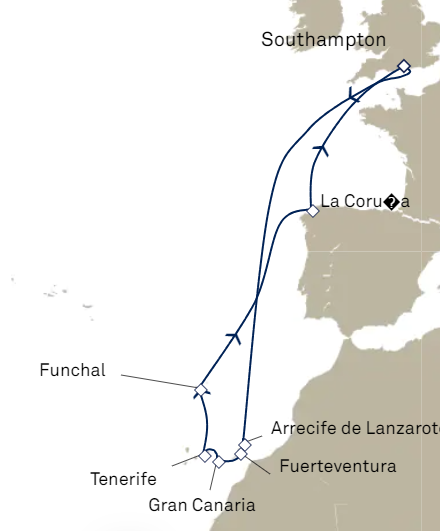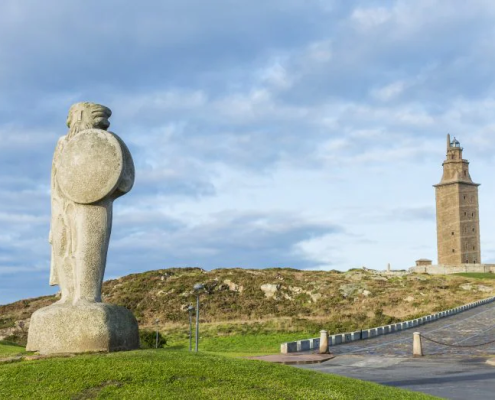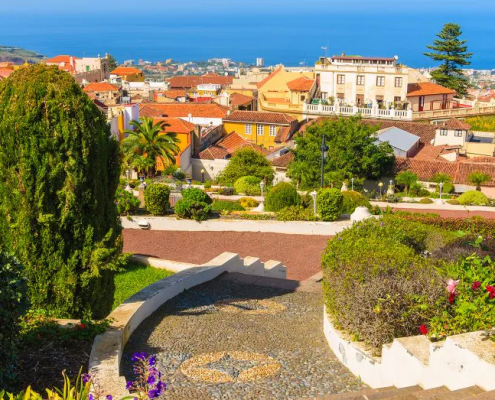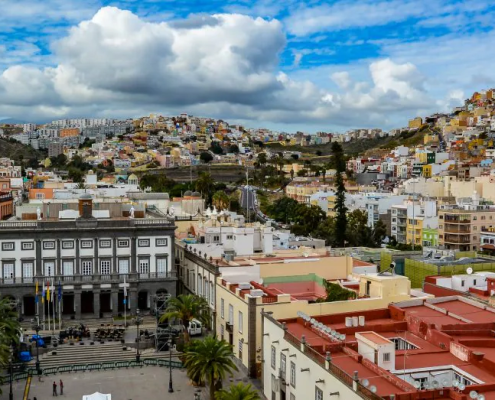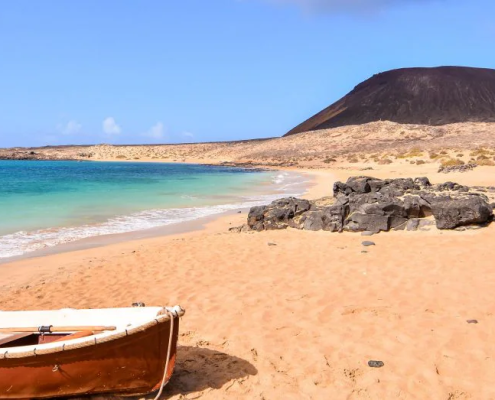Dec 26, 2024
Arrives Early morning
Departs Evening
Step into a land of mesmerizing landscapes, sun-drenched villages, volcanic beaches, and decadent cuisine.
The port city of Arrecife de Lanzarote is your gateway to the almost other-worldly enchantments of this lava-sculpted land – a capital city with a rich variety of places to explore, eat, and drink.
Arrecife de Lanzarote port guide.
A geological wonder and well-loved jewel of the Spanish Canary Islands, the port city of Arrecife lies on the east coast of Lanzarote, just 78 miles off the North coast of Africa. Offering a dry, sunny, climate with little rain, the island has long been a popular port of call for guests sailing on a cruise to the Canary Islands, as well as cruises to the Mediterranean.
There are two main docking points for ships calling at Lanzarote: Mille de Los Mármoles and La Boca de Puerto Naos. Both ports are located close to the island’s capital city of Arrecife and you can expect a warm welcome, stunning views, and plentiful opportunities to immerse yourself in traditional Lanzarote life at either location.
Top landmarks and sights in Arrecife de Lanzarote.
It’s impossible not to be taken aback by the dramatic landscape that unfurls before you as you step off your ship in Lanzarote. One of the best ways to experience this moon-like land is by visiting the Timanfaya National Park. Located on the southeast of the island, and comprised entirely of volcanic soil, the park showcases an imposing yet beautiful landscape, formed by eruptions dating back to 1720, 1736, and 1824.
If you’re interested in the history and architecture of Lanzarote, you’ll find plenty in port to keep you entertained. Among these is the opportunity to walk the causeways of the Castillo de San Gabriel – a 16th-century stone fortification situated on a tiny island overlooking Puerto Naos. The experience offers stunning outlooks over the city and across the vast blueness of the Atlantic Ocean.
Another local site of interest close to port is the Iglesia de San Gines. Proudly overlooking the gorgeously curated Arrecife old town square, this gleaming whitewashed church dazzles with its ornate beauty and roots dating back to the 1500s.
Things to do in Arrecife de Lanzarote.
The Canary Islands are also renowned for their beaches and you won’t have to stray far from port to discover soft golden sands on Lanzarote. The capital city of Arrecife is home to Playa del Reducto, where you can settle into a sun lounger amongst gently swaying palm trees or enjoy a spot of snorkeling on the nearby reef.
Traveling to the north of the island unlocks an underground treasure – Los Jameos del Agua; a place where natural beauty meets artistic flair and architectural finery. This series of natural lava caves, one of which houses a lake of crystal-clear water inhabited by albino crabs, is unlike anywhere else on earth. A second, similarly stunning, cave contains a carefully designed concert hall that hosts spectacular events and lavish dinners.
Close by to Los Jameos del Agua you can also experience the Cuevas de Los Verdes. Otherwise known as the Green Caves, this tunnel system of lava caves was formed over 5,000 years ago as a result of volcanic eruptions on the island.
Yet another Lanzarote cruise highlight, which may be of particular interest to art lovers, is the chance to visit enigmatic artist Cesar Manrique’s former home. Built around an ancient, hardened, lava flow, the site showcases an impressive blend of natural and man-made elements, where you can also view artworks by Manrique and Picasso.
Eating and drinking near Arrecife de Lanzarote cruise port.
The traditional dishes of Lanzarote make for an eclectic and exciting culinary experience that’s sure to be a highlight of your cruise. Heavily influenced by the island’s Spanish heritage, elements of African and Latin American cuisine can also be found in the dishes populating the menus of Lanzarote’s bars, cafés, and restaurants.
One of the island’s signatures is Mojo sauce, a staple not only in Lanzarote but across the Canary archipelago. Available in two varieties, red Mojo sauces are famed for their intense fiery kick, while the milder green variants are heavily aromatic, infused with fragrant garlic, herbs, and spices.
Mojo is often served alongside Papas Arrugadas, a dish of small locally grown potatoes boiled in very salty water. Once cooked, the potatoes take on a wrinkled appearance, which is why you’ll sometimes find these referred to by the nickname ‘wrinkled’ potatoes.
Another popular Lanzarote staple is Estofado. Best described as a hearty stew, Estofado often contains beef, goat, or another variety of slow-cooked meat, combined with chickpeas and seasonal vegetables. Fresh fish is also abundant in Lanzarote. If you’re seeking a recommendation, Puntillas de Calamar (whole baby squid, deep-fried and served with a squeeze of lemon) is a particular favorite with locals.
A port call to Lanzarote also presents a chance to sample a range of delicious wines, which possess a unique earthy flavor thanks to the rich, volcanic soil from which the island’s grapes are grown.
Shopping in Arrecife de Lanzarote.
One of the best areas to shop in Lanzarote is within reach just as soon as you step off your ship in port. Calle Leon y Castillo, and its surrounding streets, make up one of the most popular shopping hubs on the island and are located right in Arrecife itself. You’ll find all manner of local craft, fashion, and gift shops to browse here, together with independent boutiques selling a wide range of goods.
Hand-made souvenirs can also be found for sale in many of the smaller villages around the island, as well as amongst the stalls at the markets and bazaars that are held daily.
Getting around, Arrecife de Lanzarote transport.
Depending on where your ship docks shuttle buses are generally provided in port to take you to the main town center in Arrecife.
Taxis are also readily available at the port and throughout the city. Just look for a white cab with its green light illuminated.
If you’re hoping to travel further afield, perhaps to explore other parts of the island, a local bus service is available and tickets can be purchased either from designated bus stations or direct from the driver on board.
Multiple ferries also depart daily to some of the smaller local islands and larger Canary Islands such as Tenerife and Gran Canaria. If you do decide to travel outside of Lanzarote, be sure to check the journey times, including duration, to ensure you make it back to port in time to re-join your ship.
Arrecife de Lanzarote port facilities.
If your ship docks at Muelle de Cruceros a shuttle bus is available to ferry you the short distance to the city center. If you prefer to walk, the journey takes around 15 to 20 minutes.
The immediate area around the port is home to several small shops, a supermarket, bars, and restaurants, as well as a tourist information desk. There’s also a car rental hub, should you wish to drive independently to other parts of the island during your time in port.
Arrecife de Lanzarote quick tips.
Currency.
As part of Spain, Lanzarote and the surrounding Canary Islands’ currency is the Euro. There are plenty of ATMs available, and many establishments will accept debit or credit cards, however your card issuer may charge you for transactions you make. For this reason, we advise traveling with a small number of Euro if you plan to make any purchases ashore.
Tipping.
It’s customary to leave a tip of around 5% to 15% of your bill’s total at restaurants ashore in Lanzarote. Very few establishments will include a service charge in the final bill, but if this has been accounted for additional tipping is not expected.
At more informal bars and cafes it’s common to simply leave any leftover change from your bill, providing you’ve only stayed for one or two drinks. If you stay for longer, or order several drinks, it’s customary to tip 5%-15% of your bill’s total, as in restaurants.
For taxi rides, rounding up to the nearest whole euro note is normal, but never by more than 10%.
Weather.
Like the rest of the Canary Islands, Lanzarote enjoys a sub-tropical climate, with plentiful warm sunshine year-round.
Summer can be particularly warm and humid, with temperatures reaching around 88 F in August.
Spring and Winter are the most popular seasons to visit the island, with daily averages of a pleasant 70 F and very little rainfall – ideal for both beachgoers and explorers.



